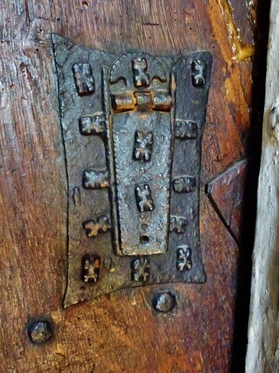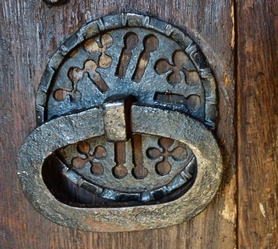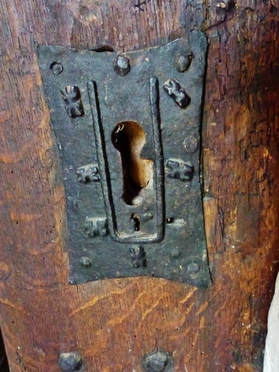A note on locked churches.
Parish churches today have many problems, and these are exacerbated close to London: congregations are often minute, costs always great; every parish must not only look after itself and its crumbling heritage, but must pay thousands of pounds as a quota to the diocesan board of finance. One of the problems with church crawling in the Home Counties is that in many places the parish church is locked, often without any keyholder named in the porch. This tends to occur in patches, with no correlation to real risk of vandalism or theft: despite the excuse often given by churchwardens, insurance companies categorically state that they prefer churches open. In much of Essex, churches are open daily, in most of Kent sadly locked: Hertfordshire is, in this as in much else, rather a curate’s egg: good in parts. I've visited every church on this site and many have been open daily. Some of those kept locked have keyholders nearby; for others prior arrangements have to be made - sometimes weeks beforehand - and a minority make access really hard work. On occasion these churches are those that have taken several grants from public funds; others fulfill public access requirements by opening during hours that are difficult for the public, which might be legal but is hardly ethical.
I’ve covered locked and open churches on this site, mostly as I've found them except for a couple of really important ones that I felt warranted extra effort.Details of any problems are on each page, though things change fast and churches that were open ten years ago in Hertfordshire are sometimes now closed. ( In East Anglia the opposite is sometimes thankfully the case !) Thieves do not care if a church is locked, they will just smash a stained glass window, or nick the lead roof. If the church is open to visitors, and especially if it is used for all manner of activities throughout the week, then it is less likely to suffer such damage. Again, why should anyone love or support a building that is always locked, that has lost much of its purpose? Church graveyards are open to us all at death, regardless of denomination; surely the time has come for the village church to be used by the whole village again, as it was in the past, seven days a week. With so many incomers to villages and towns in Hertfordshire, especially as so few are believers nowadays, a new contract of use is needed if the church is to remain at the heart of the community. In Devon, one church has let a writer set up his office in the room over the porch: with a couple of cameras, he keeps an eye on the church, and the church is open every day; surely many a church has tower or vestry that would suit such a use? Originally the laity were responsible for all but the chancel of the church: - we built their naves and towers and looked after them, they provided a focus for and proclaimed local pride, and contain much of our history and art. Can we really afford to lose them, to lock them up for minority use a couple of hours a month?
Churches are about more than religion, and we need to get away from the idea that the religious are necessarily the best people to look after them. It always shows when villagers love their church, when they have pride in it. The simplest of English parish churches starts well in front in the beautiful buildings stakes, and it requires quite an effort to destroy that lead. Sometimes you get the feeling that the congregation would rather have a nice clean modern box than have to deal with a thousand years of messy history, that the old building gets in the way of their eager evangelism, their religion of banners and leaflets; sometimes there’s been an attempt to turn the church into a living room, with carpets and chairs, and sometimes unsuitable changes take place which detract from the character of the place due to religious fashion or health and safety rules. None of this is ultimately important as long as the building is being used, and is open for people to enjoy; and now more than ever we need somewhere that consumerism isn’t king. At present, a small caucus of believers get the only say in what belongs to us all; our history, our art, our heritage, even our ancestors. Nowadays, the Church does not even take the moral lead in society and trails behind, putting the brakes on, constantly playing catch up. Can we really afford to leave all these buildings solely in their hands? They deserve exemplary care; often this seems best provided by organisations such as the Churches Conservation Trust. Such “redundant” churches fill a widespread need, not just for preservation of the past, but in retaining spaces for the future, yet diocesan lawyers often prefer to sell, dodging the ethical question of entitlement. Village churches should never be sold, but vested in charitable trusts; such a future is far preferable to privatising our past.
I’ve covered locked and open churches on this site, mostly as I've found them except for a couple of really important ones that I felt warranted extra effort.Details of any problems are on each page, though things change fast and churches that were open ten years ago in Hertfordshire are sometimes now closed. ( In East Anglia the opposite is sometimes thankfully the case !) Thieves do not care if a church is locked, they will just smash a stained glass window, or nick the lead roof. If the church is open to visitors, and especially if it is used for all manner of activities throughout the week, then it is less likely to suffer such damage. Again, why should anyone love or support a building that is always locked, that has lost much of its purpose? Church graveyards are open to us all at death, regardless of denomination; surely the time has come for the village church to be used by the whole village again, as it was in the past, seven days a week. With so many incomers to villages and towns in Hertfordshire, especially as so few are believers nowadays, a new contract of use is needed if the church is to remain at the heart of the community. In Devon, one church has let a writer set up his office in the room over the porch: with a couple of cameras, he keeps an eye on the church, and the church is open every day; surely many a church has tower or vestry that would suit such a use? Originally the laity were responsible for all but the chancel of the church: - we built their naves and towers and looked after them, they provided a focus for and proclaimed local pride, and contain much of our history and art. Can we really afford to lose them, to lock them up for minority use a couple of hours a month?
Churches are about more than religion, and we need to get away from the idea that the religious are necessarily the best people to look after them. It always shows when villagers love their church, when they have pride in it. The simplest of English parish churches starts well in front in the beautiful buildings stakes, and it requires quite an effort to destroy that lead. Sometimes you get the feeling that the congregation would rather have a nice clean modern box than have to deal with a thousand years of messy history, that the old building gets in the way of their eager evangelism, their religion of banners and leaflets; sometimes there’s been an attempt to turn the church into a living room, with carpets and chairs, and sometimes unsuitable changes take place which detract from the character of the place due to religious fashion or health and safety rules. None of this is ultimately important as long as the building is being used, and is open for people to enjoy; and now more than ever we need somewhere that consumerism isn’t king. At present, a small caucus of believers get the only say in what belongs to us all; our history, our art, our heritage, even our ancestors. Nowadays, the Church does not even take the moral lead in society and trails behind, putting the brakes on, constantly playing catch up. Can we really afford to leave all these buildings solely in their hands? They deserve exemplary care; often this seems best provided by organisations such as the Churches Conservation Trust. Such “redundant” churches fill a widespread need, not just for preservation of the past, but in retaining spaces for the future, yet diocesan lawyers often prefer to sell, dodging the ethical question of entitlement. Village churches should never be sold, but vested in charitable trusts; such a future is far preferable to privatising our past.
All rights reserved for this entire site. Copyright reserved 2013 to stiffleaf for all text and images, which may not be reproduced without my permission.




